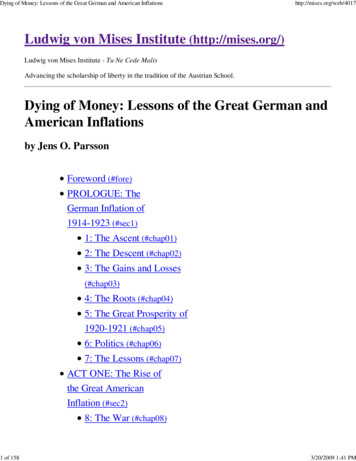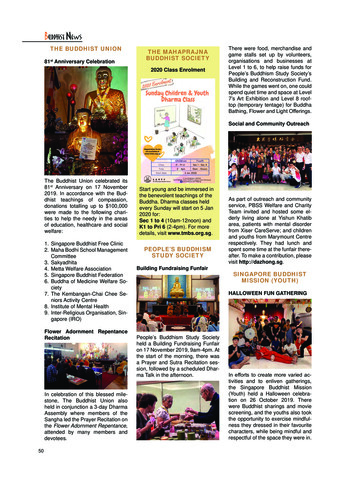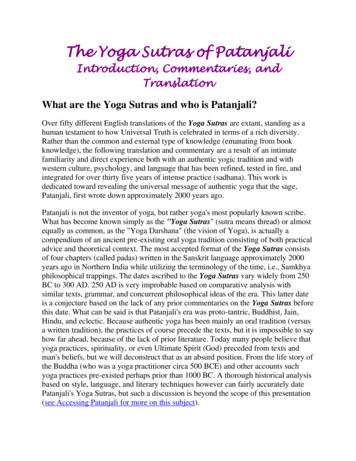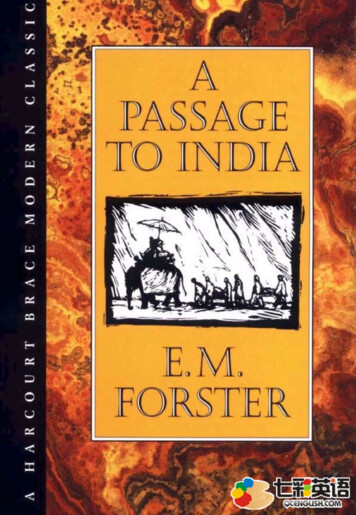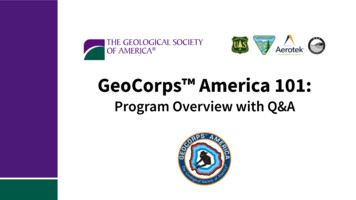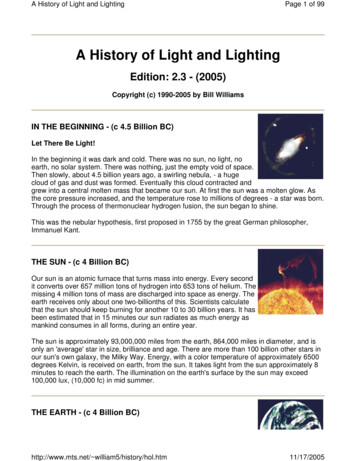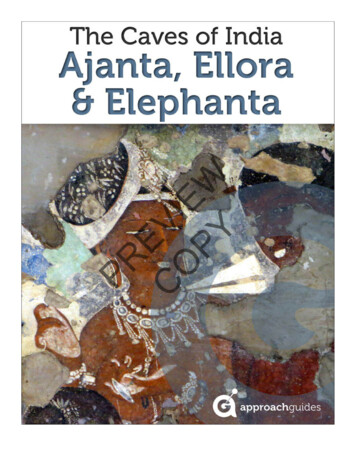
Transcription
PREC VIO EPY W
IntroductionPreviewing this book?Please check out our enhanced preview, which offers a deeper look at this guidebook.Built by Buddhist, Hindu and Jain monks as mountain retreats, India’s magnificent rock-cutsanctuaries, monasteries and temples offer travelers an unrivaled cultural experience, transporting them back to the formative stage of art and architecture for India’s indigenous religions.This Approach Guide serves as an ideal companion for travelers seeking a deeper understanding ofthis fantastic landscape, profiling India’s three premier rock-cut religious sites: Ajanta (Buddhist),Elephanta (Hindu) and Ellora (a mixture of Buddhist, Hindu and Jain). PREC VIO EPY WWhat’s in this guidebookComprehensive look at rock-cut art and architecture. We provide an overview of India’s rock-cut art and architecture, isolating trademark features that you will see again andagain as you make your way through Ajanta, Elephanta and Ellora. To make things come alive,we have packed our review with high-resolution images.A tour that goes deeper on the most important sites. Following our tradition of beingthe most valuable resource for culture-focused travelers, we offer detailed tours of the mostimpressive and representative caves at Ajanta, Elephanta and Ellora, walking step-by-stepthrough their distinctive artistic and architectural highlights. For each, we present information on its history, a detailed plan that highlights its most important architectural and artisticfeatures, high-resolution images and a discussion that ties it all together.Advice for getting the best cultural experience. To help you plan your visit, this guidebook supplies logistical advice, maps and links to online resources. Plus, we give our personaltips for getting the most from your experience while on location.Information the way you like it. As with all of our guides, this book is optimized for intuitive, quick navigation; information is organized into bullet points to make absorption easy;and images are marked up with text that explains important features.Contact us anytimeOur readers are our greatest inspiration. Email us at founders@approachguides.com to let us knowabout your experience with Approach Guides — many of our recent updates have been inspired bycustomers like you. We personally respond to every email.We hope that this cultural travel guidebook offers you fresh insights into India’s rock-cut art andarchitecture and sets you on a path to making your own discoveries.Have a great trip!
David and Jennifer RaezerFounders, Approach Guideswww.approachguides.comContinuing Travel in IndiaPREC VIO EPY WAre you continuing on to see the Islamic highlights of Delhi and Agra, the tantra-infused Hindutemples of Khajuraho, the Hindu temples in south India or the Buddhist ruins of Sri Lanka? See ourIndia guidebooks.
The Caves of India:Ajanta, Ellora and ElephantaVersion 1.1by David Raezer and Jennifer Raezer 2015 by Approach GuidesAll rights reserved. No part of this book may be reproduced in any form or by any electronic or mechanical means, without permission in writing from the publisher (excluding Creative Commons images). Further, this book is licensed foryour personal enjoyment only and may not be resold or given away to other people.Copyright, licensing and attribution information can be found in the metadata for all images and illustrations.Approach Guides and the Approach Guides logo are trademarks of Approach Guides LLC. Other marks are the propertyof their respective owners.Although every effort was made to ensure that the information was as accurate as possible, we accept no responsibilityfor any loss, damage, injury or inconvenience sustained by anyone using this guidebook.Approach GuidesNew York, NYwww.approachguides.comISBN: 978-1-936614-33-2
ContentsIntroductionRock-Cut Architecture in IndiaTOURING ITINERARYAJANTABackgroundArchitecture OverviewChaityasViharasPaintingsReliefsAjanta MapItineraryCave 1 *Cave 2 *Cave 4PREC VIO EPY WChaitya StupasCave 9Cave 10 *Cave 16 *Cave 17 *Cave 19 *Cave 26 *ELEPHANTABackgroundMap and ItineraryThe Cave’s Layout
Reliefs OverviewReliefs StyleFeatured Reliefs1. Ravana Shakes Mount Kailasa2. Shiva and Parvati Gambling3. Androgyne4. Sadashiva *5. Ganges Descends to Earth *6. Marriage of Shiva and Parvati *8. Nataraja *PREC VIO EPY W7. Shiva Slays Andhaka *9. Lord of YogisELLORABackgroundEllora MapItineraryBuddhist CavesCave 5 - MaharwadaCave 10 - Vishvakarma *Cave 12 - Tin TalHindu CavesCave 15 - Dashavatara *Cave 16 - Kailasa *Cave 21 - Rameshvara *Cave 29 - Dhumar LenaJain CavesCave 32 - Indra Sabha *LEGACY CONTINUES: CHINA
Continuing Travel in India?About Approach GuidesJoin Us!ContactFree Updates and EnhancementsPREC VIO EPY WMore from Approach Guides
Rock-Cut Architecture in IndiaThe Premier Sites for Indian Rock-Cut ArchitecturePREC VIO EPY WThis Approach Guide explores the three premier sites for rock-cut architecture in India: Ajanta, Elephanta and Ellora. In doing so, it provides insight into the development of the Buddhist and Hindurock-cut architectural traditions (see Fig. 1), from their origins at Ajanta in the 2nd century BCEthrough to their end at Ellora in the 9th century.Fig. 1. Timeline of excavation activity for India’s rock-cut architecture.Types of Stone ArchitectureThere are two types of stone architecture: Rock cut. The focus of this guidebook, rock-cut architecture is made by carving into naturalrock. Usually hewn into the sides of mountain ridges, rock-cut structures are made by excavating rock until the desired forms are achieved.Stone built. Stone-built architecture, on the other hand, involves assembling cut stonepieces to form a whole.Buddhism as Driving ForceBuddhism gets the ball rolling
— Pages Missing —Download the complete book online at www.approachguides.com
PREC VIO EPY WTOURING ITINERARYView in Google Maps.
PREC VIO EPY WAJANTA
BackgroundAuthor Tip: Ajanta is unique among India’s cave sites because it includes not only elements ofsignificant architectural interest, but also well-preserved 5th century wall paintings of a caliberthat is unrivaled in the history of Indian art.OverviewAjanta consists of 29 Buddhist caves (some unfinished), the grandest achievement of the firstwave of rock-cut architecture in India. The caves are clearly numbered from one to 29, movingeast to west; for a map of the site, see the section entitled “Ajanta Map.”PREC VIO EPY WThe caves at Ajanta have served as the reference point for Indian architectural and artistic endeavorsthroughout the centuries. Further, the styles initiated at Ajanta went on to influence cultures outsideof India, as Buddhism migrated out of India via the Silk Road to Central Asia, China and SoutheastAsia.Two Distinct Excavation PhasesCave excavation occurred in two distinct phases.Early Phase caves Ajanta’s oldest caves date from the 2nd-1st centuries BCE under the Satavahana dynasty:Caves 9 and 10 are chaitya halls; Caves 8, 12, 13 and 15A are viharas. All of these caves areassociated with the Theravada school of Buddhism.The location for these early excavations offered monks close proximity to an ancient traderoute that connected the Satavahana capital in Pratishtana (modern Paithan, just south ofAurangabad), with trade ports on India’s western coast and cities in India’s north; Ellora wasalso located on this same route.Late Phase caves Excavations did not resume until five centuries later under the Vakataka dynasty’s KingHarisena, likely from 460-478; with Harisena’s death, and the subsequent collapse of theVakataka dynasty’s control of the region, construction at the site abruptly stopped at the endof the 5th century. These caves are associated with the Mahayana school of Buddhism.All of the remaining caves date from this period: chaityas (Caves 19 and 26) and viharas(Caves 1-7, 11, 14-18, 20-25 and 27-29) are both in evidence.
— Pages Missing —Download the complete book online at www.approachguides.com
PREC VIO EPY WAjanta MapAjanta caves.
PREC VIO EPY WSatellite view of Ajanta caves. See in Google Maps.
ItineraryVisiting Location. The cave temples at Ajanta — located 100 kilometers northeast of Aurangabadand 455 kilometers northeast of Mumbai — occupy a 0.6 kilometer curve in a southeast-facing horseshoe-shaped valley cut by the Waghora river. Visiting hours. The site is open from 9am - 5:30pm. It is closed on Mondays. For moreinformation, visit the official website.Logistics. A shuttle bus takes all visitors from a staging point (called the T-Junction) to thecave temples, approximately 5 km west. The locations for shuttle pickup and ticket purchaseare marked in our Google Map of the site.Viewpoint. Depending upon your fitness level and desire for a little exercise, it is also worthconsidering a 30-minute trek to the “viewpoint,” which offers an unrivaled view of the entirecomplex (also marked on our Google Map). To get there, look for the signs as you approachthe eastern entrance to the caves; it can also be accessed from inside the site by following thesteps in front of Caves 16 and 17 down to a footbridge. PREC VIO EPY W This is a complete list of the nine Ajanta caves profiled in this guidebook. It represents our picksfor the premier caves in Ajanta. Next to each, we indicate its period (Early Phase or Late Phase), itstype (chaitya or vihara) and what makes it special.Author Tip: To make things easier and allow you to focus on the real highlights, particularlyif you have limited time, we have marked those caves that we believe are must-sees with asterisks (*) .Featured Caves Cave 1.* A Late Phase vihara, Cave 1 has the most dynamic, best-preserved paintings inAjanta.Cave 2.* A Late Phase vihara, it has good reliefs (in the secondary shrines) and high qualitypaintings throughout.Cave 4. A Late Phase vihara, the largest in Ajanta, Cave 4 has impressive reliefs.Cave 9. Excavated in the Early Phase, Cave 9 is the simplest chaitya in Ajanta. Along withCave 10, it sets in motion quintessential Buddhist forms that would go on to influence allfuture architecture — Buddhist, Hindu and Jain alike — in India.Cave 10.* An Early Phase chaitya, likely the first excavated cave in Ajanta, Cave 10 offers atrademark Theravada stupa, detailed reliefs and deteriorated Early Phase paintings.Cave 16.* A Late Phase vihara, Cave 16 has its original entrance stairway (unique in Ajanta)and a few high quality paintings.Cave 17 .* A Late Phase vihara, Cave 17 has a great collection of paintings; those that remainon the exterior pillared gallery are particularly interesting, as they can be inspected in the full
PREC VIO EPY W light of day.Cave 19.* A Late Phase chaitya, Cave 19 has a highly decorated facade, in contrast to theplain facades of Early Phase chaityas; this is consistent with the move from Theravada toMahayana Buddhism. Inside, there is a fully intact stupa (the only one remaining with itstriple umbrella chattra).Cave 26.* A Late Phase chaitya, Cave 26 is the most stunningly decorated chaitya at Ajanta;with an ornate facade and detailed all-over reliefs on the interior, it represents the culmination of the chaitya style begun nearly 700 years before.
Cave 1 *Author Tip: The tour of Ajanta starts out with a bang at this cave, which gets our vote forhaving Ajanta’s highest quality, best-preserved and well-lighted paintings. Spend as muchtime in this cave as possible; this is Ajanta at its finest.BackgroundPREC VIO EPY WCave 1, a vihara, was built in the middle of the 5th century, just after Cave 2; it corresponds to theLate Phase of excavation and is Mahayana Buddhist in religious orientation. This cave is special in that it was sponsored by the great Vakataka King Harisena, under whom the LatePhase of excavations at Ajanta was undertaken.Fig. 14. Facade, view from inside the courtyard, Cave 1, Ajanta. Highlights added.
FacadeCave 1’s facade has the most impressive decoration of any vihara at Ajanta. On the delicately fluted central columns, miniature dwarves stand with arms raised(yellow highlights in Fig. 14) on the four corners of the compressed cushion capitals, as ifsupporting the massive brackets above.A frieze (green highlights in Fig. 14) running along the top of the open pillared gallerydepicts scenes from the life of the historical Buddha.Above the entrance to the left porch is a partially damaged frieze of the Three Signs: asick man, an old man and a corpse. As a young prince, the Buddha saw each of these on hisfirst journey outside the walls of his palace; these signs convinced him that all life is suffering, a realization that led him to become a monk and embark upon finding a solution thispredicament.The eaves — projecting out ever-so-slightly from the face of the facade — are decorated withminiature chaitya arches, with faces of deities at their centers (light blue highlights inFig. 14), marking this cave as a residence of the gods.PREC VIO EPY W
PREC VIO EPY WFig. 15. Floorplan, Cave 1, Ajanta. Highlights added.Layout Just beyond a small courtyard (light blue highlights in Fig. 15) and an open pillaredgallery (dark blue highlights in Fig. 15), three doorways lead into the central hall (greenhighlights in Fig. 15).Inside, twenty square columns surround the square hall, with small cells — originally forthe monks to sleep and study — lining the periphery on the north, east and west sides; each
PREC VIO EPY W has a miniature shrine in its rear (yellow highlights in Fig. 15). The open area inside thecolumns was used as a prayer area.The columns — with compressed cushion capitals — support elaborate brackets with scenesfrom the life of the historical Buddha; these scenes are flanked by flying apsaras (see Fig. 16).Through an antechamber (pink highlights in Fig. 15) on the side opposite the entrance,a shrine room holds a seated Buddha image (red highlights in Fig. 15) displayingdharmachakra (teaching) mudra.Fig. 16. Columns with compressed cushion capitals and elaborate brackets, Cave 1, Ajanta.PaintingsCave 1 and 2 were likely the two last caves painted at Ajanta. While the paintings in Caves 2 and 17
are also world class, we believe this cave houses the most impressive 5th century paintings in the entire complex. Further, they are better preserved and illuminated, making themeven better for viewing.The paintings line the walls around the central hall. The most important paintings are reviewed inthe order that they are encountered, beginning at the entrance and continuing in clockwise rotationaround the periphery of the central hall. To help focus your viewing, we mark our favorite frescoes with asterisks (*).The overarching theme of Cave 1’s paintings centers on enlightened kingship; perhapsthis is attributable to the identity of the sponsor, King Harisena.Front wallPREC VIO EPY WThe Sibi Jataka covers the inside of the front (entrance) wall, to the left upon entering. The SibiJataka tells the story of King Sibi, a prior incarnation of the Buddha, who protects a pigeon fleeinga hawk. Sibi, recognizing the hawk’s right to kill the pigeon, agrees to give the hawk an equal weightof his own flesh on the condition that it spare the pigeon’s life. The pigeon, when placed on a scale,continues to increase in weight until it approaches that of the king himself. Nevertheless, King Sibikeeps his word and prepares to die for the pigeon, revealing his divine quality of fairness. Look forthe crowned King Sibi standing next to the scale used to weigh the pigeon (see center of Fig. 17).
— Pages Missing —Download the complete book online at www.approachguides.com
PREC VIO EPY WMap and ItineraryFig. 64. Elephanta Island, Mumbai. See detailed satellite view in Google Maps.ItineraryWe provide a detailed tour of the island’s premier site, the Great Cave, profiling its chief architecturalfeatures and its world-class reliefs.
— Pages Missing —Download the complete book online at www.approachguides.com
PREC VIO EPY WFig. 67. The two primary axes, Great Cave, Elephanta. Highlights added.Two Primary AxesThe Great Cave’s new three-entrance layout naturally encouraged the introduction of two primaryaxes (marked with red arrows in Fig. 67) along which devotees were encouraged to move; thiscompares with the single-axis arrangements of earlier Buddhist excavations. Both axes in the GreatCave direct devotees to abstract images of the presiding deity, Shiva.East-to-west axis: the devotional axisOn the east-to-west axis, visitors enter through the eastern entrance and proceed toward the shrine(green highlights in Fig. 67), at the center of which is a linga. The eastern entrance was likelydesigned to be the cave’s principal one and the east-west alignment of the ceiling moldings(between the columns) attests to its primacy.We view the east-to-west axis as the devotional axis, as it leads the devotee to a direct interactionwith the Shiva linga — a direct manifestation of the deity — in his shrine. Such personal interactionis the foundation of Hindu temple ritual. Along this axis, devotees move toward light, as the tem-
PREC VIO EPY Wple’s west side is open; this serves to backlight and highlight the linga (see Fig. 68), infusing it withan divine radiance.Fig. 68. View from eastern entrance along east-west axis, Great Cave, Elephanta.North-to-south axis: the didactic axisOn the north-to-south axis, devotees enter through the northern entrance (which servesas the modern entrance) and proceed southward toward the temple’s most important relief,that of Sadashiva (see yellow highlights in Fig. 67). See more on this image in the next section on“Reliefs.”We view this as the temple’s didactic axis, as visitors would engage with the Sadashiva relief tolearn of Shiva’s complex, opposing natures and contemplate their meanings. In opposition to theeast-to-west axis above, it represents a moving into mysterious darkness, as the Sadashiva relief liesin the darkest spot in the cave, farthest from all entrances; darkness is symbolic of the infinite andunknowable depths of divine consciousness.
— Pages Missing —Download the complete book online at www.approachguides.com
PREC VIO EPY W4. Sadashiva *Fig. 75. Sadashiva, Great Cave, Elephanta.Sadashiva — depicting the five aspects of Shiva — is the most important in the Great Caveand the most visually striking. It is also known as Trimurti, meaning three-faced.StyleFrom a stylistic standpoint, this represents the most advanced stage of Elephanta reliefs.Sadashiva — carved so deep in relief and projecting so far from the back of the niche — takes on theappearance of an in-the-round sculpture. As a result, the massive three-headed figure appears to berising from the basalt stone of the mountain itself.
NarrativeSadashiva represents Shiva in his most enigmatic form, the embodiment of all the opposing forces in the universe. Shiva’s five aspects are: Aghora, Vamadeva, Tatpurusha, Sadyojataand Ishana. Of these, only three are visible here: Aghora — represented by the male deity, Bhairava — faces east (the left side). It is symbolicof the terrifying aspect of Shiva, in which he serves as the destructive, renovating forceof the universe. Aghora holds a serpent and is shown with serpent locks in his hair and asnarling face.Vamadeva — represented by the female deity, Uma, the earth goddess — faces west (theright side). It is symbolic of Shiva’s opposite aspect, that of the healing and preservingforce. Vamadeva is depicted with gentle features and holds a lotus flower.Tatpurusha faces north, directly at the visitor. It represents duality (manifest in Aghoraand Vamadeva, male and female) resolved into the unity of absolute knowledge, thecontrolling and sustaining force of the universe. Tatpurusha naturally combines bothmale and female facial characteristics; it holds a lemon in its left hand, symbolic of fecundity. PREC VIO EPY WThe two others are not shown:Sadyojata — represented by Mahadeva — faces south, away from the viewer; its presence isimplied, as a fourth face could not be depicted in this arrangement. It represents the creative power of the universe.Finally, Ishana — Sadashiva itself — faces upwards and is Shiva’s supreme aspect, responsible for granting moksha (liberation) from the cycle of rebirths that accompanies enlightenment. This aspect is never depicted, as it lies beyond human comprehension.
— Pages Missing —Download the complete book online at www.approachguides.com
PREC VIO EPY WEllora MapEllora caves.
PREC VIO EPY WSatellite view of Ellora caves. See in Google Maps.
ItineraryVisiting Location. The 34 caves at Ellora — located 30 kilometers northwest of Aurangabad and 350kilometers northeast of Mumbai — are spread out over 2.2 kilometers along a north-southrunning escarpment; for the most part, caves face westward. Ellora was located on an ancienttrade route that connected the interior part of Maharashtra with trade ports on India’s western coast and cities in India’s north; Ajanta was one of the original sites on this same route.Visiting hours. The caves are open from 9am - 5:30pm. The site is closed on Tuesdays.Tickets are purchased directly in front of Cave 16. For more information, visit the official website.Starting point. The car-shuttle dropoff location for most visitors is directly before Cave 16,Kailasa (see our Google Map).PREC VIO EPY W Featured CavesOur tour of Ellora features the top cave sites, following the typical progression from south to north: Buddhist caves 1-12 (red highlights on our map);Hindu caves 13-29 (blue highlights)Jain caves 30-34 (green highlights).
— Pages Missing —Download the complete book online at www.approachguides.com
PREC VIO EPY WFig. 85. Facade, Cave 10, Ellora. Highlights added.FacadeConsistent with Ajanta’s Late Phase chaityas, Cave 10’s facade has abundant decoration. The columns on the lower level’s pillared gallery have square shafts. The capitalsconsist of stylized pots, seemingly overflowing with foliage; they are symbolic of prosperity.This is an early manifestation of this capital style; it will become significantly more elaboratein later caves, particularly Caves 12 (Buddhist), 16 (Hindu) and 32 (Jain).
PREC VIO EPY W The upper hall has the classic chaitya window, resembling a 3/4 circle (green highlightsin Fig. 85). While its shape is consistent with Ajanta models, it is much smaller inscale and therefore plays a smaller role in shaping the overall appearance of thefacade.Each side of the window is flanked by three flying apsaras above a twisting naga (serpent).There are two friezes, each decorated with a series of tightly framed scenes ofamorous couples in swaying, dynamic poses. The first is on the stone balustrade on the upperlevel’s verandah (yellow highlights in Fig. 85) and the second is on the pediment of the upperfloor (red highlights in Fig. 85).The ceiling over the entrance to the upper level is decorated with stone ribs that imitateearlier wooden beams (light blue highlights in Fig. 85).Fig. 86. Floorplan, Cave 10, Ellora. Highlights added.LayoutThis two-level structure represents the ultimate expression of the Buddhist chaitya inIndia: A large open courtyard (yellow highlights in Fig. 86) provides access, through a pillared
PREC VIO EPY W gallery (light blue highlights in Fig. 86), to the interior of the chaitya.The apsidal-ended hall holds 28 octagonal columns that divide the space into a narrowcentral nave (for prayer) and two side aisles (for circumambulation).The internal stupa (red highlights in Fig. 86) sits opposite the entrance; it is fronted by aseated Maitreya Buddha, the Buddha of the Future.The upper floor, consisting of a verandah and a musicians’ gallery, is accessed through astairway on the left side of the pillared gallery.Fig. 87. Frieze, Cave 10, Ellora.Internal DecorationThe nave’s relief decoration is simpler than that of Late Phase Ajanta protoypes. Perhaps this was done to focus attention on the stupa’s primary Buddha figure (discussed next). The simple octagonal columns surrounding the stupa support undecorated brackets, astep back from the ornate capitals of Ajanta.A frieze — again simpler than those of Late Phase Ajanta — runs above them (see Fig. 87). It
consists of seated Buddhas displaying the dharmachakra mudra; they are flanked by pairs ofattendants. At the Buddhas’ feet is a thin register of miniature figures, with arms raised, whoappear to be supporting the Buddhas’ platform; above, bridging the gap from the frieze tothe stone ribs of the ceiling, are stout figures, arms clasped to their chests in prayer.As is typical, the nave’s curved vault ceiling has stone ribs (see Fig. 88) that imitate earlierwooden beams.Ajanta and Ellora: Stupa Forms ComparedIn the earlier discussion of Ajanta, we reviewed the changing form of the chaitya’s stupa, from itsEarly Phase in the 1st and 2nd centuries BCE (under Theravada Buddhism) to its Late Phase in the5th century CE (under Mahayana Buddhism). Altogether, this transformation yielded an increased emphasis on the Buddha image and a commensurate de-emphasis of the stupa; thesetrends are consistent with the Mahayana school. PREC VIO EPY WCave 10 basically continues the trend where it left off at Ajanta. Accordingly, it shares many featureswith Ajanta’s most developed stupa arrangement, that of Late Phase Cave 26:The anda (green highlights in Fig. 88) is smaller and 3/4 egg shaped, like Cave 26,rather than 3/4 sphere shaped like Early Phase versions. It sits on an elevated platform(yellow highlights in Fig. 88), affording the overall structure greater upward momentum.The harmika (red highlights in Fig. 88) remains generally consistent with earlier prototypes.The Buddha is positioned boldly in front of the stupa. You will remember thatrepresentations of the Buddha were not allowed in the early centuries of the faith underTheravada Buddhism; only with the emergence of the Mahayana sect — this, the progressiveschool of Buddhism, was formed in the 2nd century CE — did such representations begin.Just as at Ajanta’s Cave 26, he is seated and displays the dharmachakra (teaching) mudra.
PREC VIO EPY WFig. 88. Stupa, Cave 10, Ellora. Highlights added.Despite these similarities, Cave 10 goes a bit further, creating the most developed chaityastupa arrangement on Indian soil. The most notable change is the markedly increased sizeof the Buddha figure. His scale is now massive, in sharp contrast to the more human-sized Buddhas in Ajanta; for comparison purposes, see Fig. 89 of Ajanta’s Cave 26.Seated in a Western manner (both feet on the floor), he is flanked (for the first time) by attendantsand backed by a large Bodhi tree. Further, he is positioned in an even more forward, approachable position, as opposed to the enclosed position (under the stupa canopy) at Ajanta.
PREC VIO EPY WFig. 89. Stupa, Cave 26 (late 5th century), Ajanta. Highlights added.These modifications further attest to the changed nature of ritual under the Mahayanaschool of Buddhism: the worship of an abstract symbol (the stupa) is de-emphasized in favor ofa more concrete, identifiable Buddha figure, with whom the devotee can interact on a personal level.
— Pages Missing —Download the complete book online at www.approachguides.com
Continuing Travel in India?PREC VIO EPY WAre you continuing on to see the Islamic highlights of Delhi and Agra, the tantra-infused Hindutemples of Khajuraho, the Hindu temples in south India or the Buddhist ruins of Sri Lanka? See ourIndia and Sri Lanka guidebooks.
India Reading ListWe’ve re-imagined the travel reading list for those seeking more rewarding and fulfilling experiencesaround the world. Explore our collection of “Trip Reads” — expertly-curated print books, ebooks,magazine articles, papers from leading academics, online resources, music, podcasts, videos andmore.Here are just a few of our India recommendations (see the complete list): 660 Curries Easy-to-follow recipes with curries from throughout India. Includes both traditional, regional and contemporary curries. By Raghavan Iyer.“Citizens Jain” Why India’s newspaper industry is thriving. By Ken Auletta.Sounds of India: Hindustani Listen to a playlist containing a personal collection of tracksfeaturing North India’s signature Hindustani music compiled by our founder Jennifer Raezer.The perfect pre-trip soundtrack.The Little Book of Hindu Deities Just for kids! Entertaining book that brings the gods,goddesses, and stories of Hindu mythology to life. By Sanjay Patel.We encourage you visit tripreads.com to get our Trip Reads for India and other destinations throughout the world. Enjoy your travels!
PREC VIO EPY WABOUT APPROACH GUIDESTravel guidebooks for the ultra curious Exclusive focus on cultural sites. Currently available for over 60 destinations worldwide,Approach Guides are focused exclusively on providing deep insight into your destination’sbest cultural sites and experiences.Designed for digital. Guidebooks are designed from the ground up for digital, the idealformat for today’s traveler.More interactive and visually oriented. High-resolution images — maps, photos, floorplans, and illustrations — are often marked up with text to ease identification of key architectural and artistic elements.Organized to make touring easy. Featuring bullet points and fast navigation, ApproachGuides make it effortless to absorb key themes and follow the itinerary.Advice for getting the best cultural experience. To help with planning, guidebooks offer logistical advice and provide links to online resources. Plus, we provide our personal tipsfor getting the most from your experience while on location.Free updates. All guidebooks are marked with version numbers; when we update a guidebook, existing customers can easily download the update for free.Contact
Email us at founders@approachguid
the eastern entrance to the caves; it can also be accessed from inside the site by following the steps in front of Caves 16 and 17 down to a footbridge. This is a complete list of the nine Ajanta caves profiled in this guidebook. It represents ou

